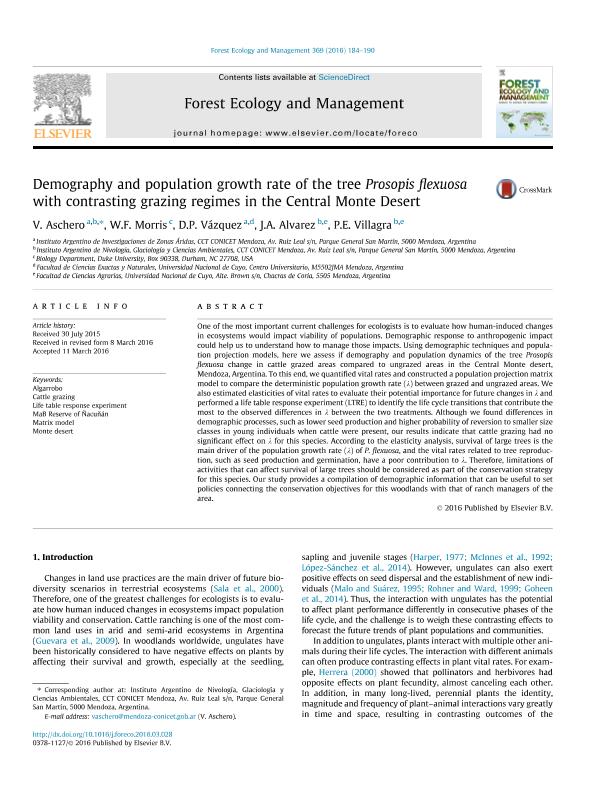Mostrar el registro sencillo del ítem
dc.contributor.author
Aschero, Valeria

dc.contributor.author
Morris, W.F.
dc.contributor.author
Vazquez, Diego P.

dc.contributor.author
Alvarez, Juan Agustin

dc.contributor.author
Villagra, Pablo Eugenio

dc.date.available
2018-05-18T20:39:45Z
dc.date.issued
2016-06
dc.identifier.citation
Aschero, Valeria; Morris, W.F.; Vazquez, Diego P.; Alvarez, Juan Agustin; Villagra, Pablo Eugenio; Demography and population growth rate of the tree Prosopis flexuosa with contrasting grazing regimes in the Central Monte Desert; Elsevier Science; Forest Ecology and Management; 369; 6-2016; 184-190
dc.identifier.issn
0378-1127
dc.identifier.uri
http://hdl.handle.net/11336/45660
dc.description.abstract
One of the most important current challenges for ecologists is to evaluate how human-induced changes in ecosystems would impact viability of populations. Demographic response to anthropogenic impact could help us to understand how to manage those impacts. Using demographic techniques and population projection models, here we assess if demography and population dynamics of the tree Prosopis flexuosa change in cattle grazed areas compared to ungrazed areas in the Central Monte desert, Mendoza, Argentina. To this end, we quantified vital rates and constructed a population projection matrix model to compare the deterministic population growth rate (k) between grazed and ungrazed areas. We also estimated elasticities of vital rates to evaluate their potential importance for future changes in k and performed a life table response experiment (LTRE) to identify the life cycle transitions that contribute the most to the observed differences in k between the two treatments. Although we found differences in<br />demographic processes, such as lower seed production and higher probability of reversion to smaller size classes in young individuals when cattle were present, our results indicate that cattle grazing had no significant effect on k for this species. According to the elasticity analysis, survival of large trees is the main driver of the population growth rate (k) of P. flexuosa, and the vital rates related to tree reproduction, such as seed production and germination, have a poor contribution to k. Therefore, limitations of activities that can affect survival of large trees should be considered as part of the conservation strategy for this species. Our study provides a compilation of demographic information that can be useful to set policies connecting the conservation objectives for this woodlands with that of ranch managers of the area.
dc.format
application/pdf
dc.language.iso
eng
dc.publisher
Elsevier Science

dc.rights
info:eu-repo/semantics/openAccess
dc.rights.uri
https://creativecommons.org/licenses/by-nc-sa/2.5/ar/
dc.subject
Cattle
dc.subject
Monte Desert
dc.subject
Prosopis
dc.subject
Matrix Model
dc.subject.classification
Otras Ciencias Biológicas

dc.subject.classification
Ciencias Biológicas

dc.subject.classification
CIENCIAS NATURALES Y EXACTAS

dc.title
Demography and population growth rate of the tree Prosopis flexuosa with contrasting grazing regimes in the Central Monte Desert
dc.type
info:eu-repo/semantics/article
dc.type
info:ar-repo/semantics/artículo
dc.type
info:eu-repo/semantics/publishedVersion
dc.date.updated
2018-04-18T20:20:47Z
dc.journal.volume
369
dc.journal.pagination
184-190
dc.journal.pais
Países Bajos

dc.journal.ciudad
Amsterdam
dc.description.fil
Fil: Aschero, Valeria. Consejo Nacional de Investigaciones Científicas y Técnicas. Centro Científico Tecnológico Conicet - Mendoza. Instituto Argentino de Nivología, Glaciología y Ciencias Ambientales. Provincia de Mendoza. Instituto Argentino de Nivología, Glaciología y Ciencias Ambientales. Universidad Nacional de Cuyo. Instituto Argentino de Nivología, Glaciología y Ciencias Ambientales; Argentina. Consejo Nacional de Investigaciones Científicas y Técnicas. Centro Científico Tecnológico Conicet - Mendoza. Instituto Argentino de Investigaciones de las Zonas Áridas. Provincia de Mendoza. Instituto Argentino de Investigaciones de las Zonas Áridas. Universidad Nacional de Cuyo. Instituto Argentino de Investigaciones de las Zonas Áridas; Argentina
dc.description.fil
Fil: Morris, W.F.. University of Duke; Estados Unidos
dc.description.fil
Fil: Vazquez, Diego P.. Consejo Nacional de Investigaciones Científicas y Técnicas. Centro Científico Tecnológico Conicet - Mendoza. Instituto Argentino de Investigaciones de las Zonas Áridas. Provincia de Mendoza. Instituto Argentino de Investigaciones de las Zonas Áridas. Universidad Nacional de Cuyo. Instituto Argentino de Investigaciones de las Zonas Áridas; Argentina
dc.description.fil
Fil: Alvarez, Juan Agustin. Consejo Nacional de Investigaciones Científicas y Técnicas. Centro Científico Tecnológico Conicet - Mendoza. Instituto Argentino de Nivología, Glaciología y Ciencias Ambientales. Provincia de Mendoza. Instituto Argentino de Nivología, Glaciología y Ciencias Ambientales. Universidad Nacional de Cuyo. Instituto Argentino de Nivología, Glaciología y Ciencias Ambientales; Argentina
dc.description.fil
Fil: Villagra, Pablo Eugenio. Consejo Nacional de Investigaciones Científicas y Técnicas. Centro Científico Tecnológico Conicet - Mendoza. Instituto Argentino de Nivología, Glaciología y Ciencias Ambientales. Provincia de Mendoza. Instituto Argentino de Nivología, Glaciología y Ciencias Ambientales. Universidad Nacional de Cuyo. Instituto Argentino de Nivología, Glaciología y Ciencias Ambientales; Argentina
dc.journal.title
Forest Ecology and Management

dc.relation.alternativeid
info:eu-repo/semantics/altIdentifier/url/https://www.sciencedirect.com/science/article/pii/S0378112716301049
dc.relation.alternativeid
info:eu-repo/semantics/altIdentifier/doi/https://doi.org/10.1016/j.foreco.2016.03.028
Archivos asociados
